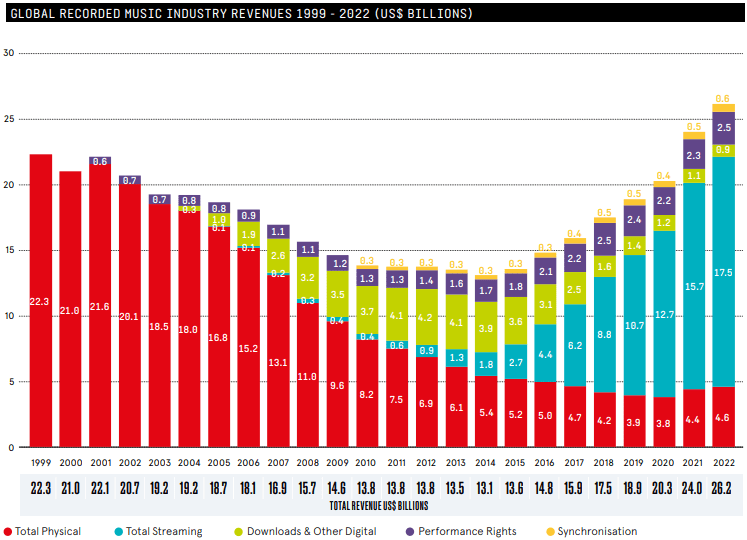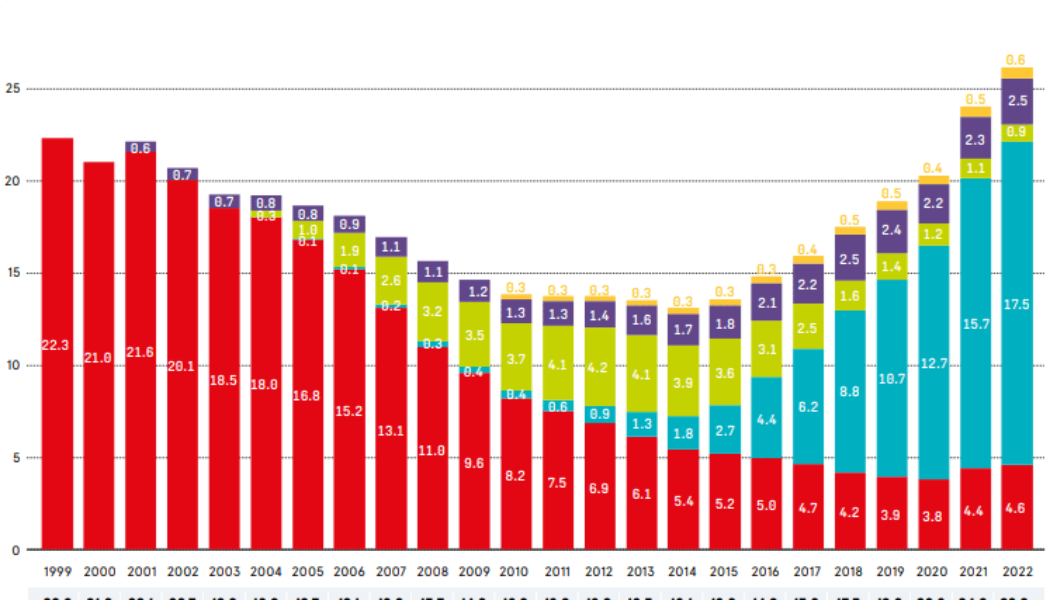The South African market was the surprise star performer of the global music industry over the past year.
As unlikely as it would have seemed in recent years, given general stagnation in the local industry, growth in South Africa was singled out as a highlight in the Global Music Report 2023, released last week by the International Federation of the Phonographic Industry (IFPI).
The much-anticipated report shows that the global market grew by 9% to $26-billion last year. The fastest growing region: Sub-Saharan Africa. And, according to IFPI, this growth was driven mostly by growth in South Africa, as the region’s biggest market.
Music sales in South Africa had grown only marginally in 2021, by 2.4%, but leaped by a huge 31% in 2022.
More significantly, growth in the region anchored global growth, although IFPI says the recorded music market saw growth in every region across the globe.
“Four regions posted double-digit gains, outpacing the overall growth rate of 9.0% and Sub-Saharan Africa overtook Middle East and North Africa as the fastest growing area.
“With a steep increase of 34.7%, and the only region to see more than 30% growth, Sub-Saharan Africa became the fastest growing region for recorded music revenues in 2022. Growth was boosted by a strong climb in revenues in South Africa, the region’s largest market (+31.4% versus a modest 2.4% growth the prior year)”.

According to the IFPI, global growth is driven by local cultures.
Adam Granite Universal Music Group’s CEO for Africa, Middle East and Asia, says in the report that “music has always been incredibly important to cultures around the world – literally since the dawn of civilisation”.
“What we are now witnessing, helped by the expansion of the smartphone, is the explosion of accessibility. Billions of people around the world now have portable music with them at all times. And with this access has come a massive expansion of music services, some free and some paid. This in turn has fueled our investment into more markets, genres and ultimately artists, than ever before.
“What is most exciting, however – despite all of our phenomenal industry growth over the past several years – is that in many ways we are still at the beginning stages of the development of the ecosystem on a global basis. There are literally billions more consumers we expect to enter in the coming years.”
Simon Robson, president for international recorded music at Warner Music Group, says in the report that, while growth continues around the world, music markets in different countries are at different stages of development. This in turn required different priorities and demanded different strategies from the record companies that are engaging and investing in them.
“When we look at the global market, we see the strong growth coming from areas such as Asia, Latin America, Middle East and North Africa (MENA), and Sub-Saharan Africa, where emerging markets are continuing to grow and evolve.”
Antos Stella, head of Music Arena, which encompasses both leading recording company Gallo and pan-African music distribution service Content Connect Africa (CCA), told us that there were two main factors behind the surge in the region.

“First, the growth is a result of a massive race for market share and subsequently a big investment in marketing with the main digital streaming platforms.
“Second, the Amapiano genre drove hits, and artists like DJ Maphorisa and Kabza attracted a bigger streaming audience in South Africa.”
Music streaming leader Spotify reported this week that its data showed Amapiano tracks generated close to 2-billion streams last year, representing a 143% increase over 2021.
It said: “The genre has garnered a huge following, with more than 240,000 playlists featuring Amapiano in the title and over 10-million playlists featuring at least one Amapiano track. Over 40% of Amapiano streams come from listeners outside South Africa.”
This helps to balance the scales a little. Stella says reports she has seen show that international content outsells South African content by almost 50% in this country. However, Music Arena saw growth similar to that reported by IFPI.
“Collectively CCA and Gallo, having one of the biggest catalogues on the continent, experienced an increase in line with the 31%, as the businesses focused on marketing and services to support our artists.”
She fully expects the growth momentum to be maintained.
“This will continue, particularly with various partnerships between locally-focused streaming services like Mdundo and Boomplay, and a bigger investment in local talent. North Africa has also seen a big increase in streaming, and I think we should not take our eyes of Nigeria, Ghana and East Africa. We have seen how massive the likes of Davido, Wizkid and Burna Boy are globally.
“We constantly look at redefining the businesses and keeping ahead of the curve. Arena’s commitment to investing in the African music industry will result in better services and opportunities for artists.”
It’s not all wine and roses for the artists, however. Stella says the changes brought about in the local music business by streaming are her biggest concern.
“If we break down all these figures, what does it mean to the artist? Individually with streams there has to be a whole lot more investment in digital marketing to even begin to see a return for the content creator. The artist has to sell over 50,000 streams (on average) to earn US$200, depending on the digital streaming service, and this is before the various fees of aggregation, distribution, etc are deducted. However I am confident that we will continue to evolve into a more artist centric business which will result in fair play for all stakeholders.”
Temi Adeniji, MD of Warner Music Africa, agreed in the IFPI report that the streaming revolution was potentially a positive development: “Across the continent, we’re seeing users switch from traditional media to digital platforms. That shift is benefiting artists and music as they’re at the heart of mainstream digital platforms, from audio streaming to short-form video.
“A challenge for the music industry as a whole is to convert users from ad-based services to paid subscription. In South Africa, for example, we only have around four million paid subscribers in a country of nearly 50-million people. So, we have to make sure that more ad-based services act as a funnel to subscription.”
* This feature first appeared in Business Times in the Sunday Times.









